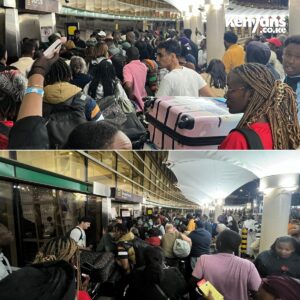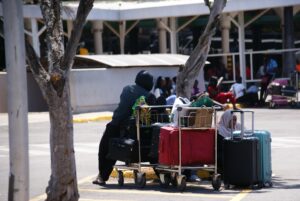The current strike and debates on JKIA in Nairobi are a wake-up call to the Kenyan travel and tourism industry. The disruptions at JKIA, the country’s leading international gateway, impact local and international passengers and the overall tourism industry.
Analyzing the effects of the JKIA saga, this article explores how travel and tourism have been affected in Kenya.
The JKIA Strike: A Major Breakthrough

It has paralyzed operations, including ticket operations, customer support, check-ins, and other services that travelers rely on while on a journey or waiting for a flight.
On September 11, 2024, JKIA was almost closed throughout the day over a strike by aviation workers against the planned airport leasing to India’s Adani Group. The strike led to:
- Many travelers are left behind at the airport
- Some of the challenges the respondents faced include long queues and the scarcity of help from airport staff.
- That the domestic and international flights either cancel or delay their operation.
- The cultures: little information given to travelers on rescheduled flights
The Kenya Airports Authority (KAA) apologized for the inconvenience, but the damage had already been done. Many people were stuck in the middle, unsure of when they would be able to continue their journeys.
Regional Ripple Effects
The strike’s impact extended beyond Kenya’s borders, affecting regional air travel across East Africa:
- RwandAir said that it would cancel all its flights that were due to commence.
- Uganda Airlines affirmed that there could be possible delays and disruptions.
- Ethiopian Airlines reported saying that it has been continuously working on reducing inconveniences to passengers.
These disruptions led not only to passengers being stranded at JKIA, but also at Entebbe and Kigali among other regional airports.
The Adani Group Controversy

Proposed Takeover and Investment
The strike is based on the contentious plan to have the Indian conglomerate Adani Group manage JKIA. Key aspects of the deal include:
- The JKIA concession agreement included a 30-year concession period for managing and operating the terminal.
- A proposed $750 million to be invested in upgrading airport terminals.
- The projection appears to expand the capacity to 33 million by 2055.
- Expansion of necessary new facilities and amenities on the city side
Although the government wants Kenyans to consider this investment as a way of improving JKIA, the proposition has met with considerable resistance.
Opposition and Legal Challenges
The proposed deal has encountered resistance on multiple fronts:
- From a safety perspective, aviation workers are also concerned that the new measure may cost jobs.
- Several issues have been raised, including what has been referred to as the ‘shaded’ or ‘clouded’ nature of the deal.
- Petition to courts by human and legal activist groups
- A temporary suspension of the leasing plan by the court
These factors have contributed to the current unrest and uncertainty surrounding JKIA’s future.
Immediate Effects on Travel and Tourism

Disrupted Travel Plans
The most immediate effect of the JKIA saga has been on travelers:
- Flight disruptions such as cancellations and delays lead to passengers’ missed connections.
- Vagueness resulting in changes in movement plans
- It indicates that the travelers incur several more bucks in the form of rebooking fees and additional nights of accommodation due to flight disruptions.
These disruptions may fuel negative experiences and perceptions of traveling to Kenya among the target audience.
Economic Losses for Airlines and Tourism Operators
The strike and ongoing uncertainty are causing financial strain:
- Financial impacts for airlines mainly include the cancellation of flights
- This results in reduced room bookings due to the instability and political unrest that makes tourists seek safer countries.
- Resorts that have experienced cancellations and rescheduling problems
The longer the situation remains untreated, the more damage it can cause to Kenya’s aviation and tourist industries.
Long-Term Consequences for Kenya’s Tourism Industry

Damage to Kenya’s Reputation
The JKIA saga could have lasting effects on Kenya’s image as a tourist destination:
- Awareness of insecurity and unsoundness concerning air travel.
- Groups of negative feedback and travelers’ testimonies about the situation
- These adverse effects may include losing confidence in international tour operators and travel agencies.
Regaining visitors’ trust and promoting Kenya as one of the best tourism hubs in Africa may take time and effort.
Impact on Tourism Numbers and Revenue
If the situation at JKIA remains unresolved, it could lead to:
- Decreased international visitor arrivals
- Loss of business for the service industries in the country
- Layoffs of potential jobs for those in the tourism and hospitality industries
Since tourism is one of Kenya’s main sources of employment and foreign exchange, the fluctuation could affect other aspects of the economy.
The Way Forward: Balancing Development and Stability

Need for Transparent Dialogue
To resolve the JKIA saga and mitigate its impact on travel and tourism, stakeholders must prioritize:
- Communication between the government the aviation employees, and other private investors
- Some of the breakdowns include the transparency of information sharing of the proposed deal with the Adani Group
- Responding to the issues of insecurity of job and the long-term management of JKIA
Maintaining Business Continuity During Transitions
Regardless of the outcome, steps must be taken to maintain JKIA’s functionality:
- Maintaining contingency plans to address Interruptions
- Enhancing interactions with travelers during times of crises
- Increasing staff capacity and equipment for improving airport operations
Diversifying development with national interests
The government must carefully weigh the benefits of private investment against potential risks:
- Securing any given agreements in a way that would safeguard Kenyan employment and earnings.
- Sustaining the supervision of strategic centers such as JKIA would also balance the consolidation of authority in the state.
- Taking into account the options for financing the construction of airports
Conclusion
Without a doubt, JKIA’s experience has dealt a major blow to Kenya’s travel and tourism industry business. It is quite rational to have plans to modernize and expand the airport.
Still, the issue with the Adani Group contract has created a lot of noise and uncertainty that can negatively affect the sector’s longevity.
In this situation, various stakeholders should unite and look for a solution that will be favorable for all the parties involved, including the workers and the rest of Kenya, which are interested in the growth of the tourism sector.
Only with open and constructive communication, strategic thinking, and a desire to continue evolving Kenya as a world-class travel destination can the nation successfully navigate the current obstacles and forge a better, healthier aviation and tourism industry.





